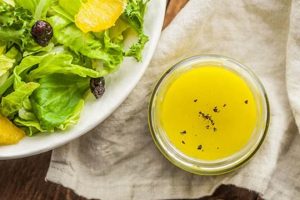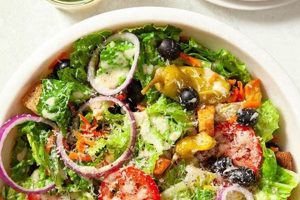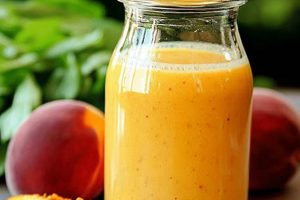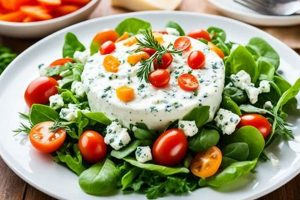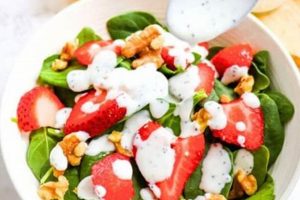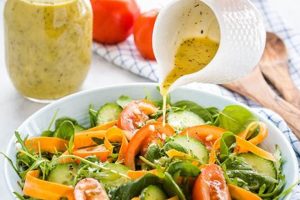Emulsified mixtures of mayonnaise and other ingredients create a creamy, flavorful base for salads. These dressings can range from simple additions of herbs and spices to more complex blends incorporating dairy, sweeteners, or savory elements like mustard and anchovies. Classic examples include Ranch, Thousand Island, and creamy blue cheese dressings.
Such dressings offer several culinary advantages. Their rich texture clings well to salad ingredients, ensuring even flavor distribution. Mayonnaise provides a stable emulsion, preventing separation and maintaining a desirable consistency. Furthermore, these versatile dressings can be adapted to suit a wide array of salads, from leafy greens to pasta and potato salads. Historically, mayonnaise-based dressings have evolved from simple homemade concoctions to mass-produced staples, reflecting changing tastes and culinary trends.
This article will further explore the world of creamy salad dressings, delving into specific recipe variations, nutritional considerations, and tips for creating the perfect emulsion at home.
Tips for Crafting Delicious Mayonnaise-Based Dressings
Creating exceptional mayonnaise-based dressings involves understanding key principles and employing effective techniques. The following tips offer guidance for achieving optimal flavor and texture.
Tip 1: Use High-Quality Mayonnaise: The foundation of a successful dressing lies in the quality of its base. Opting for a mayonnaise made with real eggs and minimal additives will yield superior results.
Tip 2: Balance Flavors: Achieving a harmonious blend of flavors is crucial. Consider the interplay of sweet, sour, salty, and savory elements. A touch of acidity, such as lemon juice or vinegar, can brighten the dressing.
Tip 3: Incorporate Fresh Herbs and Spices: Freshly chopped herbs and spices elevate the flavor profile. Experiment with combinations like dill, chives, parsley, or tarragon. Dried spices, used sparingly, can also add depth.
Tip 4: Adjust Consistency: Desired consistency can be achieved through the addition of liquids. Milk, buttermilk, or even water can thin the dressing, while Greek yogurt can add body.
Tip 5: Emulsify Thoroughly: Proper emulsification prevents separation and creates a smooth, creamy texture. Whisking ingredients together vigorously or using a blender ensures a stable emulsion.
Tip 6: Taste and Adjust: Tasting the dressing throughout the preparation process allows for adjustments. Fine-tune the seasoning and balance of flavors to achieve the desired profile.
Tip 7: Refrigerate Before Serving: Chilling the dressing allows the flavors to meld and enhances the overall experience. Refrigeration also helps stabilize the emulsion.
By following these guidelines, one can consistently create delicious and well-balanced mayonnaise-based dressings that complement a variety of salads and dishes. These tips provide a solid foundation for culinary exploration and customization.
With these foundational techniques in place, one can confidently explore a world of flavor combinations and create dressings tailored to individual preferences. The next section will provide specific recipe examples to inspire culinary creativity.
1. Base
Mayonnaise serves as the foundational element in mayonnaise-based salad dressings, providing the characteristic creamy texture and a neutral flavor profile that allows for versatile customization. Its emulsification properties are essential for binding other ingredients and creating a stable, cohesive dressing.
- Emulsion Stability:
Mayonnaise is an emulsion of oil and water, stabilized by egg yolks. This stability is crucial in dressings, preventing separation and maintaining a smooth, consistent texture. Without a stable emulsion, the dressing would break down, resulting in an unappetizing oily layer on top.
- Flavor Neutrality:
Mayonnaise possesses a relatively neutral flavor, allowing other ingredients to shine. This blank canvas allows for a wide range of flavor profiles, from tangy and herbaceous to sweet and savory. The subtle richness of mayonnaise complements rather than overpowers other components.
- Texture and Mouthfeel:
The creamy texture of mayonnaise contributes significantly to the overall sensory experience of the dressing. It coats salad ingredients evenly, providing a luxurious mouthfeel and enhancing the delivery of flavors. This clinging quality also helps prevent the dressing from pooling at the bottom of the salad bowl.
- Versatility and Adaptability:
Mayonnaise acts as a versatile base, readily accepting a wide array of additions. From classic combinations like herbs and spices to more adventurous inclusions like fruit purees or roasted vegetables, mayonnaise adapts to diverse flavor profiles, enabling culinary creativity.
The properties of mayonnaise as an emulsion, its neutral flavor profile, creamy texture, and adaptability are integral to the success of mayonnaise-based salad dressings. Understanding these aspects allows for informed recipe development and customization, ensuring a delicious and satisfying culinary experience.
2. Flavor
The interplay of sweet, sour, and savory elements is paramount in crafting well-balanced and nuanced mayonnaise-based salad dressings. A harmonious blend of these flavor profiles elevates the dressing beyond a simple condiment, transforming it into an integral component of the overall culinary experience. Careful consideration of these elements ensures a dressing that complements, rather than overpowers, the other ingredients in the salad.
- Sweetness
Sweetness in salad dressings can be derived from various sources, including honey, maple syrup, or sugar. It provides a counterpoint to acidity and savory notes, rounding out the flavor profile. A touch of sweetness can also help balance the richness of the mayonnaise. For example, a honey-mustard dressing utilizes the sweetness of honey to temper the sharpness of mustard and create a balanced flavor profile.
- Sourness/Acidity
Acidity, often provided by vinegar or citrus juice, introduces a brightness and tang that cuts through the richness of the mayonnaise. It adds a refreshing element and helps to awaken the palate. Lemon juice in a Caesar dressing, for instance, provides a vibrant acidity that contrasts with the creamy dressing and salty Parmesan cheese.
- Savory Notes
Savory elements contribute depth and complexity to mayonnaise-based dressings. Ingredients such as garlic, onion, herbs, spices, and cheeses introduce umami and other savory nuances. A Ranch dressing, with its blend of herbs, garlic, and onion, exemplifies the role of savory notes in creating a well-rounded flavor profile.
- Balance and Harmony
The key to a successful dressing lies in achieving a delicate balance between sweet, sour, and savory components. No single element should dominate, allowing for a harmonious interplay of flavors. This balance ensures that the dressing enhances the overall salad experience without overpowering the other ingredients. Consider a creamy dill dressing, where the subtle sweetness of dill balances the tang of vinegar and the richness of the mayonnaise.
By understanding the role and interplay of sweet, sour, and savory elements, one can create mayonnaise-based salad dressings that are not only flavorful but also contribute to the overall balance and complexity of a dish. These flavor principles provide a foundation for crafting dressings that elevate the culinary experience.
3. Texture
The creamy, smooth texture is a defining characteristic of mayonnaise-based salad dressings, directly influencing the sensory experience and overall appeal. This texture arises from the emulsification process inherent in mayonnaise production, where oil and water are combined and stabilized by egg yolks. The resulting emulsion creates a smooth, viscous consistency that coats salad ingredients evenly, enhancing flavor delivery and mouthfeel. A dressing lacking this characteristic smoothness may appear separated or watery, detracting from the culinary experience.
The importance of this creamy texture extends beyond mere aesthetics. It plays a functional role in flavor perception and enjoyment. The even coating of ingredients ensures consistent flavor distribution, preventing pockets of intense flavor or blandness. The smooth texture also contributes to a luxurious mouthfeel, enhancing the overall palatability of the salad. Consider the contrast between a creamy Caesar dressing clinging uniformly to crisp romaine lettuce and a thin, watery vinaigrette that pools at the bottom of the bowl. The former offers a more satisfying and flavorful experience due to the consistent texture and flavor delivery.
Achieving the desired creamy, smooth texture requires attention to ingredient quality and preparation techniques. Using fresh, high-quality mayonnaise is essential, as lower-quality versions may be prone to separation or possess an undesirable grainy texture. Proper emulsification techniques, whether through vigorous whisking or the use of a blender, ensure a stable and homogenous mixture. Furthermore, the addition of other ingredients, such as sour cream or yogurt, can further enhance the creaminess and adjust the viscosity of the dressing. Challenges may arise when incorporating acidic ingredients, which can sometimes destabilize the emulsion. Careful addition and thorough mixing can mitigate this risk. Ultimately, mastering the art of achieving a creamy, smooth texture is crucial for creating appealing and enjoyable mayonnaise-based salad dressings.
4. Ingredients
The quality of ingredients directly impacts the flavor, texture, and overall success of mayonnaise-based salad dressings. Fresh, high-quality components contribute not only to superior taste but also to a more appealing visual presentation and enhanced nutritional value. The use of subpar ingredients can result in a dressing that is bland, lacks vibrancy, or even develops off-flavors. For instance, using stale herbs or spices will result in a muted, less aromatic dressing compared to one made with fresh herbs. Similarly, low-quality mayonnaise, often containing excessive additives and stabilizers, can negatively impact the overall flavor and texture of the final product. The difference between a dressing made with fresh-squeezed lemon juice versus bottled lemon juice is often noticeable, with the fresh juice offering a brighter, more vibrant flavor profile. Furthermore, choosing high-quality oils, such as extra virgin olive oil, can introduce subtle flavor nuances and contribute to a healthier nutritional profile.
This principle extends beyond the core ingredients of mayonnaise, oil, and vinegar. Fresh herbs, spices, and other additions play a significant role in shaping the final character of the dressing. Wilted herbs or aged spices will lack the vibrancy and potency of their fresh counterparts, resulting in a less flavorful dressing. Consider the difference between a Ranch dressing made with fresh chives and parsley versus one made with dried, stale herbs. The fresh herbs impart a bright, herbaceous flavor, while the dried herbs may contribute a dull, almost dusty taste. Similarly, using freshly minced garlic versus pre-minced garlic from a jar yields a more pungent and aromatic flavor profile. The emphasis on ingredient quality is paramount in achieving a truly exceptional mayonnaise-based dressing. This principle is reflected in professional kitchens where chefs prioritize sourcing the freshest, highest-quality ingredients to create exceptional dishes.
Selecting fresh, high-quality ingredients is not merely a culinary best practice but a crucial factor in maximizing the flavor potential of mayonnaise-based salad dressings. The investment in quality ingredients translates directly to a superior sensory experience, enhancing the overall enjoyment of the dish. While cost considerations may sometimes factor into ingredient selection, prioritizing quality whenever possible ensures a more satisfying and flavorful outcome. This understanding empowers culinary exploration and allows for a deeper appreciation of the impact of ingredient quality on the final product. It allows for the creation of dressings that not only complement the salad but elevate it to a new level of culinary excellence. The subtle nuances of flavor derived from fresh, high-quality ingredients contribute to a more complex and rewarding dining experience.
5. Technique
Emulsification and blending are fundamental techniques in creating successful mayonnaise-based salad dressings. They dictate the final texture, stability, and even flavor distribution. Proper execution of these techniques ensures a smooth, creamy, and homogenous dressing that complements the salad, rather than separating into an unappetizing mixture. The understanding and application of these techniques distinguish a well-crafted dressing from a mediocre one.
- Emulsification
Emulsification is the process of combining two immiscible liquids, such as oil and water, into a stable mixture. In mayonnaise-based dressings, the egg yolk acts as an emulsifier, binding the oil and water molecules together. This process creates the characteristic creamy texture and prevents the dressing from separating. A broken emulsion results in an oily layer on top of the dressing, significantly impacting its palatability and visual appeal. Achieving a stable emulsion is therefore critical for both the aesthetic and sensory qualities of the dressing.
- Blending
Blending refers to the thorough incorporation of all ingredients into a homogenous mixture. This technique ensures uniform flavor distribution and a smooth texture, preventing clumps or pockets of undiluted ingredients. Different blending methods, such as whisking, blending with an immersion blender, or using a food processor, can be employed depending on the desired consistency and ingredients. For instance, a chunky blue cheese dressing may benefit from a gentle hand-whisking to maintain some texture, while a smooth Ranch dressing requires more vigorous blending for a homogenous consistency.
- Impact on Texture and Stability
Both emulsification and blending directly influence the texture and stability of the dressing. Proper emulsification ensures a smooth, creamy texture and prevents separation. Thorough blending eliminates lumps and creates a consistent mouthfeel. The interplay of these techniques is crucial for creating a dressing that is both visually appealing and texturally satisfying. A poorly emulsified dressing may be thin and watery, while insufficient blending can lead to a grainy or uneven texture.
- Flavor Distribution
Effective blending ensures that flavors are evenly distributed throughout the dressing. This prevents localized concentrations of certain ingredients, ensuring a balanced and harmonious flavor profile in each bite. For example, in a herb-based dressing, proper blending ensures that the herbs are evenly dispersed, preventing pockets of intense herb flavor and ensuring a consistent taste experience.
Mastering the techniques of emulsification and blending is essential for creating high-quality mayonnaise-based salad dressings. These techniques contribute significantly to the texture, stability, and flavor distribution of the dressing, ultimately impacting the overall culinary experience. A deep understanding of these processes empowers culinary creativity and ensures the creation of dressings that are both visually appealing and deliciously satisfying. By employing these techniques effectively, one can consistently produce dressings that elevate any salad from simple to exceptional.
6. Customization
The adaptability and versatility of mayonnaise-based salad dressings represent a significant advantage for culinary exploration and customization. This inherent flexibility allows for the creation of dressings tailored to specific flavor preferences, dietary needs, and seasonal ingredient availability. Mayonnaise serves as a neutral canvas, readily accepting a wide array of additions and modifications, transforming it from a simple condiment to a versatile culinary tool.
- Flavor Profiles
Mayonnaise-based dressings can accommodate an immense range of flavor profiles, from classic combinations like Ranch and Thousand Island to more innovative creations. The addition of herbs, spices, cheeses, fruits, vegetables, and other flavoring agents allows for endless customization. This adaptability allows chefs and home cooks alike to create dressings perfectly suited to specific dishes and palates. For example, a simple garlic and herb dressing can be transformed into a vibrant cilantro-lime dressing with a few ingredient swaps, demonstrating the ease with which flavor profiles can be adjusted.
- Dietary Adaptations
The versatility of mayonnaise-based dressings extends to accommodating various dietary restrictions. Substituting traditional mayonnaise with vegan alternatives, such as those made from aquafaba or avocado, allows for the creation of plant-based versions of classic dressings. Furthermore, ingredient substitutions can address specific allergies or sensitivities. For example, using maple syrup instead of honey allows individuals avoiding honey to enjoy a sweet and tangy dressing. This adaptability ensures inclusivity and allows for a wider range of dietary preferences to be catered to.
- Seasonal Variations
Mayonnaise-based dressings offer the opportunity to incorporate seasonal ingredients, reflecting the freshest flavors available. Spring dressings might feature fresh herbs like dill and chives, while summer variations could incorporate ripe tomatoes and basil. Autumnal dressings could showcase roasted butternut squash or pumpkin, and winter dressings could utilize dried cranberries or citrus fruits. This adaptability allows for a dynamic and evolving culinary experience, celebrating the seasonality of ingredients.
- Texture Modifications
The texture of mayonnaise-based dressings can also be customized to suit specific preferences and dishes. The addition of ingredients like sour cream or Greek yogurt can increase the creaminess and body of the dressing, while buttermilk or water can thin it out. Pureeing roasted vegetables or fruits into the dressing can create a thicker, more textured consistency. This control over texture allows for the creation of dressings that perfectly complement the other elements of the dish, whether a light and crisp salad or a heartier pasta salad.
The capacity for customization underscores the value of mayonnaise-based salad dressings as a versatile culinary tool. This adaptability allows for the creation of dressings that not only enhance the flavor of salads but also cater to individual preferences, dietary needs, and seasonal ingredient availability. This flexibility empowers culinary creativity and ensures that mayonnaise-based dressings remain a relevant and adaptable element in a diverse range of culinary applications. From simple adjustments to more complex modifications, the possibilities for customization are vast, making these dressings a valuable asset in any kitchen.
Frequently Asked Questions
This section addresses common inquiries regarding the preparation and utilization of mayonnaise-based salad dressings.
Question 1: How can separation in a mayonnaise-based dressing be prevented?
Proper emulsification is key. Ensure thorough whisking or blending of ingredients. Adding ingredients slowly and at similar temperatures also aids in emulsion stability. If separation occurs, a small amount of hot water, whisked in drop by drop, can often re-emulsify the dressing.
Question 2: What are suitable substitutes for mayonnaise in dressings for individuals with dietary restrictions?
Vegan mayonnaise alternatives, often made from ingredients like aquafaba or avocado, provide suitable substitutes. Greek yogurt or silken tofu, blended until smooth, can also offer a creamy texture, though the flavor profile will differ.
Question 3: How long can mayonnaise-based dressings be stored safely?
Properly stored in an airtight container in the refrigerator, most mayonnaise-based dressings can be stored for up to one week. Observe for any signs of spoilage, such as changes in odor, texture, or color, before consuming.
Question 4: How can the thickness of a mayonnaise-based dressing be adjusted?
Adding liquids like water, milk, or buttermilk can thin a dressing. Conversely, incorporating ingredients like Greek yogurt, sour cream, or pureed fruits or vegetables can thicken the consistency.
Question 5: What are effective methods for enhancing the flavor of a basic mayonnaise-based dressing?
Fresh herbs, spices, and flavorful additions like roasted garlic, grated cheese, or citrus zest can elevate a basic dressing. Consider incorporating a touch of acidity, such as lemon juice or vinegar, to brighten the flavor profile.
Question 6: Can mayonnaise-based dressings be used for purposes other than salad dressings?
Their versatility extends beyond salads. They can serve as dips for vegetables or chips, spreads for sandwiches, or flavorful toppings for grilled meats or fish.
Understanding these common concerns and their solutions allows for greater confidence in the preparation and utilization of mayonnaise-based dressings. These insights promote successful culinary endeavors and enhance the enjoyment of these versatile condiments.
Further exploration of specific recipe variations will follow in the next section, providing practical examples of the principles discussed.
Conclusion
Mayonnaise-based salad dressing recipes offer a versatile and adaptable foundation for culinary creativity. From the fundamental principles of emulsification and blending to the nuanced interplay of sweet, sour, and savory flavors, understanding the core components allows for the creation of dressings tailored to individual preferences and culinary applications. The emphasis on fresh, high-quality ingredients underscores the potential for exceptional flavor profiles, while the adaptability of these dressings accommodates dietary restrictions and seasonal variations. Proper technique ensures a smooth, creamy texture and consistent flavor distribution, elevating the sensory experience.
The exploration of these recipes extends beyond mere culinary practice; it represents a journey into the art of flavor composition and texture manipulation. Continued experimentation and refinement of technique promise a deeper understanding of the potential held within the seemingly simple combination of mayonnaise and complementary ingredients. This ongoing exploration enriches culinary experiences and underscores the enduring relevance of mayonnaise-based salad dressings in the world of gastronomy.

